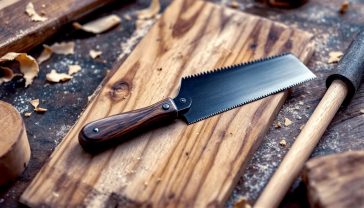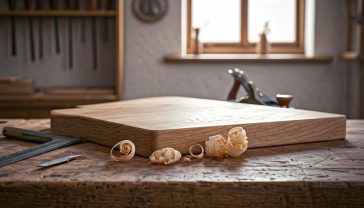An Artisan’s Guide: 6 of the Best Japanese Hardwoods for Woodworking
Explore the top 6 Japanese hardwoods. Learn about their unique grains, properties, and best uses for woodworking projects here in the UK.

This post may contain affiliate links. If you make a purchase through these links, we may earn a commission at no additional cost to you.
Ever watched a master craftsperson at work and wondered how they make it look so easy? A lot of it comes down to their tools and materials. In the world of woodworking, few materials are as revered as Japanese hardwoods. For centuries, these remarkable timbers have been the heart and soul of everything from sacred temples and samurai swords to delicate tea ceremony utensils and beautiful furniture. They’re not just lumps of wood; they’re a piece of Japan’s history and culture, shaped by its unique climate and forests.
But what makes them so special? It’s a combination of strength, beauty, and a certain spirit that woodworkers call ki-shitsu, or the wood’s character. Working with Japanese hardwood is like having a conversation with nature itself. Each plank tells a story of the mountain it grew on, the seasons it weathered, and the tradition it represents.
For woodworkers here in the UK, getting your hands on these timbers can feel like uncovering a hidden treasure. They offer a chance to bring a touch of Japanese elegance—that famous sense of simplicity and respect for nature—into our own workshops and homes. Whether you’re a seasoned pro or just starting, understanding these woods can transform your craft.
In this guide, we’ll take a journey into the forests of Japan to explore six of the very best hardwoods. We’ll look at what makes each one unique, where it comes from, and how you can use it to create something truly special. So, grab a cuppa, and let’s dive into the wonderful world of Japanese hardwoods.
What Makes Japanese Hardwoods a Cut Above the Rest?
Before we meet our top six, it’s worth asking: what’s all the fuss about? After all, we’ve got lovely oak, ash, and beech right here in Britain. While our native timbers are fantastic, Japanese hardwoods bring something different to the workbench.
First, there’s the climate. Japan’s varied weather, from snowy winters in the north to humid summers in the south, creates trees that grow slowly. This slow growth results in wood with a very tight, dense grain. Think of it like the rings on a tree. The closer the rings, the stronger and more stable the wood. This density makes Japanese hardwoods incredibly durable and resistant to warping or splitting, which is a huge plus for any woodworker.
Second is the culture of forestry. For generations, Japanese foresters have managed their woodlands with incredible care. This isn’t just about chopping down trees for profit; it’s a sustainable practice called satoyama, where forests are carefully tended to ensure they thrive for centuries. This meticulous approach means the timber harvested is often of exceptional quality, with fewer knots and imperfections.
Finally, there’s the aesthetic. Japanese design, known as wabi-sabi, finds beauty in simplicity, imperfection, and nature. The hardwoods reflect this perfectly. They often have subtle colours, elegant grain patterns, and a warmth that feels both natural and sophisticated. They’re not flashy, but they have a quiet confidence that speaks volumes. This makes them perfect for creating pieces that are both functional and beautiful, embodying a sense of calm and harmony.
So, while a piece of English oak has the strength of a castle, a piece of Japanese Keyaki has the grace of a temple. Both are brilliant, but they offer a different feel, a different story, and a different creative journey.
Now, let’s get to know the stars of the show.
1. Keyaki (Zelkova serrata) – The Unshakeable King
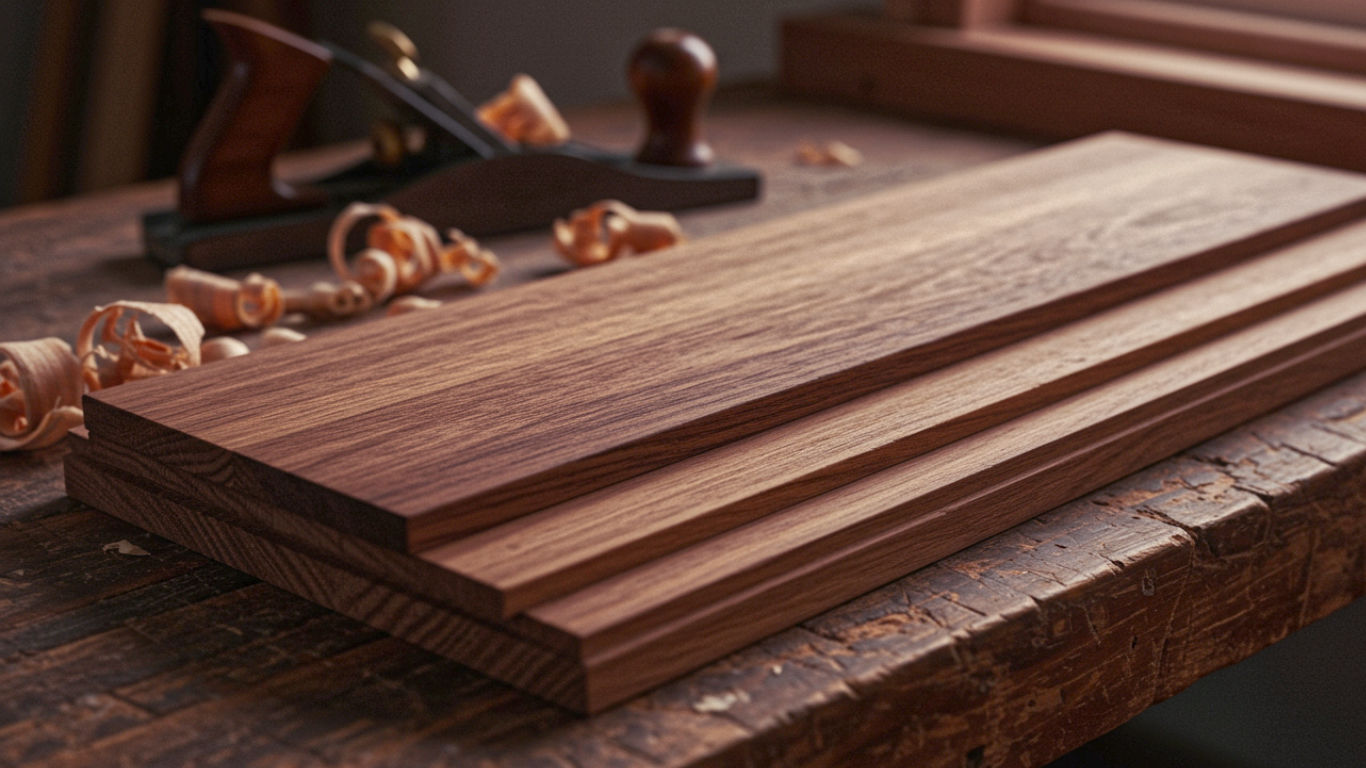
If Japanese hardwoods had a king, it would undoubtedly be Keyaki. Often called Japanese Elm, this magnificent wood is celebrated for its incredible strength, durability, and breathtaking grain. It’s the timber of choice for structures that need to last an eternity, like the main pillars of temples and shrines, and the hefty beams in traditional castles.
What Makes Keyaki So Special?
The first thing you’ll notice about Keyaki is its dramatic grain. It often features a bold, interlocking pattern that swirls and dances across the board. When cut in a particular way (quartersawn), it reveals stunning silvery flecks, a bit like the medullary rays you see in high-quality oak. Its colour ranges from a warm golden-brown to a reddish-orange, and it darkens beautifully with age, developing a rich, deep patina that only time can create.
But Keyaki isn’t just a pretty face. It’s one of the toughest hardwoods in Japan. It’s incredibly resistant to rot and insects, which is why it was used for anything that needed to withstand the elements. It’s also very heavy and dense, making it ideal for furniture that needs to be sturdy and reliable. Think of a solid dining table that will host family gatherings for generations—that’s a job for Keyaki.
A Wood with a Soul
In Japanese culture, Keyaki is more than just timber; it’s a symbol of strength and longevity. Because these trees can live for over a thousand years, the wood is believed to carry a powerful spirit. It’s often used for making traditional taiko drums, where its resonance and strength produce a deep, thunderous sound that’s said to echo the voice of the gods.
Working with Keyaki: A Rewarding Challenge
Let’s be honest—Keyaki isn’t the easiest wood to work with. Its interlocking grain, which gives it that beautiful pattern, can be a nightmare for hand tools. It’s prone to tear-out, so you need exceptionally sharp planes and chisels. If you’re a power tool user, you’ll need to take shallow passes and be patient.
However, the reward is well worth the effort. Once you get it smooth, Keyaki takes a finish like a dream. A simple oil finish is often all that’s needed to make the grain pop and bring out its natural lustre. It also holds details very well, making it great for carving.
Best Uses for Keyaki:
- High-End Furniture: Think statement pieces like dining tables, cabinets, and chests.
- Architectural Features: Beams, posts, and traditional Japanese joinery.
- Turnery and Carving: It’s great for bowls, platters, and decorative items.
- Musical Instruments: Especially the powerful taiko drums.
For a British woodworker, Keyaki is a bit like a very distinguished old oak. It demands respect and skill, but if you treat it right, it will reward you with a piece that’s strong, beautiful, and timeless.
2. Kuri (Japanese Chestnut) – The Humble Powerhouse
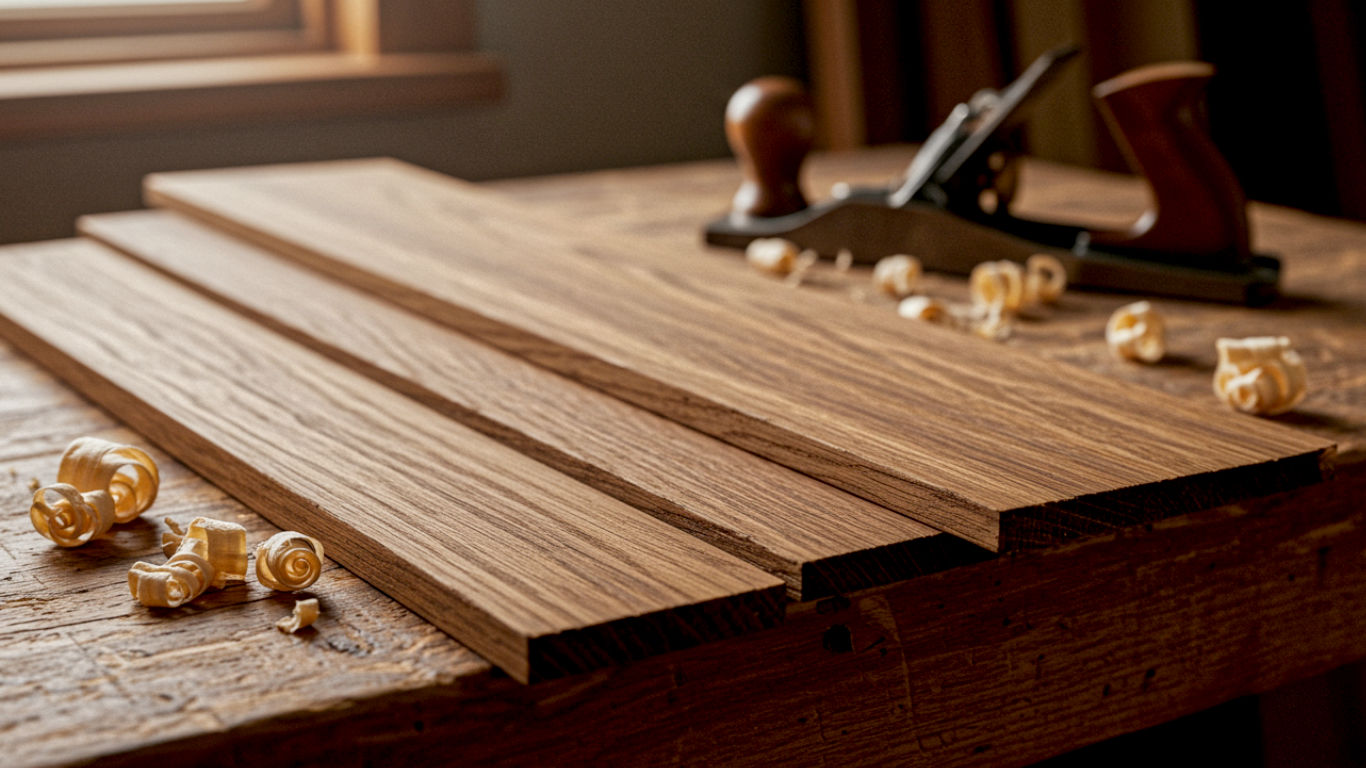
While Keyaki might be the king, Kuri, or Japanese Chestnut, is the dependable, hardworking backbone of Japanese woodworking. It’s a bit more understated than Keyaki, but don’t let its humble appearance fool you. This wood is incredibly strong, durable, and versatile, making it a favourite for everything from flooring and furniture to railway sleepers.
What Makes Kuri So Special?
Kuri shares some similarities with our own Sweet Chestnut here in the UK, but it has a character all its own. The wood has a lovely golden-brown colour, which mellows over time to a soft, silvery-grey if left unfinished outdoors. Its grain is typically straight and open, with a slightly coarse texture that gives it a rustic, honest charm.
But its real superpower is its natural durability. Kuri is packed with tannins, which are natural compounds that make the wood highly resistant to rot, decay, and insects. This is why it was traditionally used for the foundations of houses and for posts that were set directly into the ground. It’s a wood you can rely on, even in damp British weather.
A Wood of Practicality and Warmth
Historically, Kuri was the wood of the people. While nobles and priests built their temples from prized Keyaki and Hinoki (a softwood), ordinary folk used Kuri for their homes and tools. It was plentiful, easy to work with, and incredibly long-lasting. This gives Kuri a warm, unpretentious feel. It’s a wood that’s meant to be used and lived with.
It was also a vital food source. The chestnuts themselves were a staple of the Japanese diet for centuries, so the tree was deeply respected for providing both shelter and sustenance.
Working with Kuri: A Joy for Hand Tools
If you love working with hand tools, you’ll love Kuri. Its straight grain makes it a dream to plane, saw, and chisel. It splits cleanly, which is great for traditional joinery techniques like mortise and tenons. While it’s strong, it’s not overly dense, so it doesn’t blunt your tools as quickly as something like Keyaki.
One thing to be aware of is its high tannin content. These tannins can react with iron and steel, causing black or blue stains on the wood. This is known as iron stain. To avoid this, it’s best to use stainless steel or bronze screws and fittings. When finishing, the open grain can be filled to create a silky-smooth surface, or left as it is for a more natural, textured feel. An oil finish works beautifully, enhancing its warm, golden tones.
Best Uses for Kuri:
- Furniture: Especially rustic or farmhouse-style tables, chairs, and benches.
- Flooring and Cladding: Its durability makes it perfect for high-traffic areas.
- Outdoor Projects: Think garden furniture, gates, and fence posts.
- Kitchenware: It’s great for cutting boards and utensils due to its hard-wearing nature.
For a British woodworker, Kuri is like a reliable old friend. It’s easy to get along with, forgiving of the odd mistake, and will stick with you for years to come. It’s the perfect choice for creating pieces with a warm, rustic charm.
3. Tochi (Japanese Horse Chestnut) – The Silky, Rippling Beauty
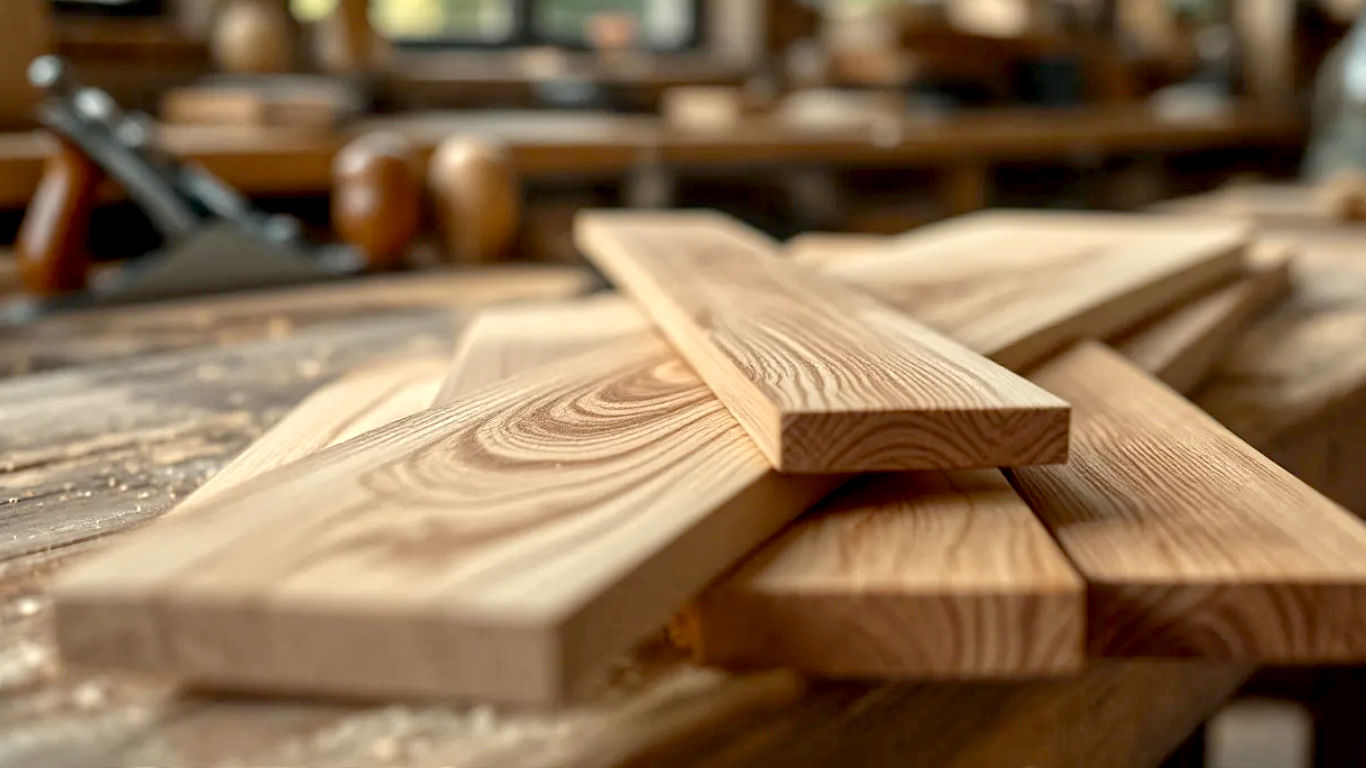
If Kuri is the practical workhorse, then Tochi, or Japanese Horse Chestnut, is the artist’s muse. This wood is all about visual appeal. It’s famous for its silky lustre and stunning figured grain patterns, which can ripple and shimmer like water. It’s a wood that woodturners and furniture makers dream of.
What Makes Tochi So Special?
Tochi is a much lighter wood than Keyaki or Kuri, both in colour and in weight. Its colour is a pale, creamy white or pale yellow, often with a pearlescent sheen that seems to glow from within. This light colour makes it a perfect canvas for showing off its incredible grain.
And what a grain it is! Tochi is renowned for producing a wide variety of figure, including quilt, burl, and a mesmerising ripple effect known as chijimi-moku. This figuring is caused by the wood fibres growing in an irregular, wavy pattern. When the wood is planed and finished, these waves catch the light in different ways, creating a three-dimensional effect that’s simply breathtaking. It’s like the wood is alive.
A Wood for Treasures
Because of its beauty, Tochi has always been prized for decorative items. It’s often used for making luxury furniture, musical instruments, and intricate boxes for storing precious things like tea ceremony utensils or calligraphy tools. Its smooth, fine texture and light weight also make it ideal for carving.
The Tochi tree itself is also culturally significant. Its nuts, like those of the Kuri, were an important food source in ancient Japan, especially in mountainous regions. This connection to sustenance gives the wood a gentle, nurturing quality.
Working with Tochi: Handle with Care
Tochi is a delight to work with, but it requires a delicate touch. It’s a relatively soft hardwood, so it can dent or scratch easily if you’re not careful. Its fine, straight grain (when not figured) makes it easy to cut and shape. However, when you’re working with a highly figured piece, you need to be mindful of tear-out, especially when planing. Using a very sharp blade with a high cutting angle, or relying on scrapers and sandpaper, is often the best approach.
The real magic happens at the finishing stage. Because of its light colour and fine pores, Tochi can be finished in many ways. A clear lacquer or oil will enhance its natural shimmer, while a light stain can be used to add a touch of colour without obscuring the grain. It polishes to a silky-smooth, almost buttery finish that’s irresistible to touch.
Best Uses for Tochi:
- Fine Furniture: Especially cabinet doors, drawer fronts, and tabletops where the figure can be shown off.
- Veneers: Its stunning patterns make it a top choice for decorative veneers.
- Musical Instruments: Guitars, violins, and traditional Japanese instruments like the koto.
- Woodturning and Carving: It’s perfect for creating beautiful bowls, vases, and sculptures.
For a British woodworker, Tochi is like a piece of sycamore with a magical secret. On the surface, it’s pale and unassuming, but once you start working it, you uncover a world of shimmering, rippling beauty. It’s the perfect wood for creating a true showstopper.
4. Kiri (Paulownia) – The Lightest Hardwood in the World
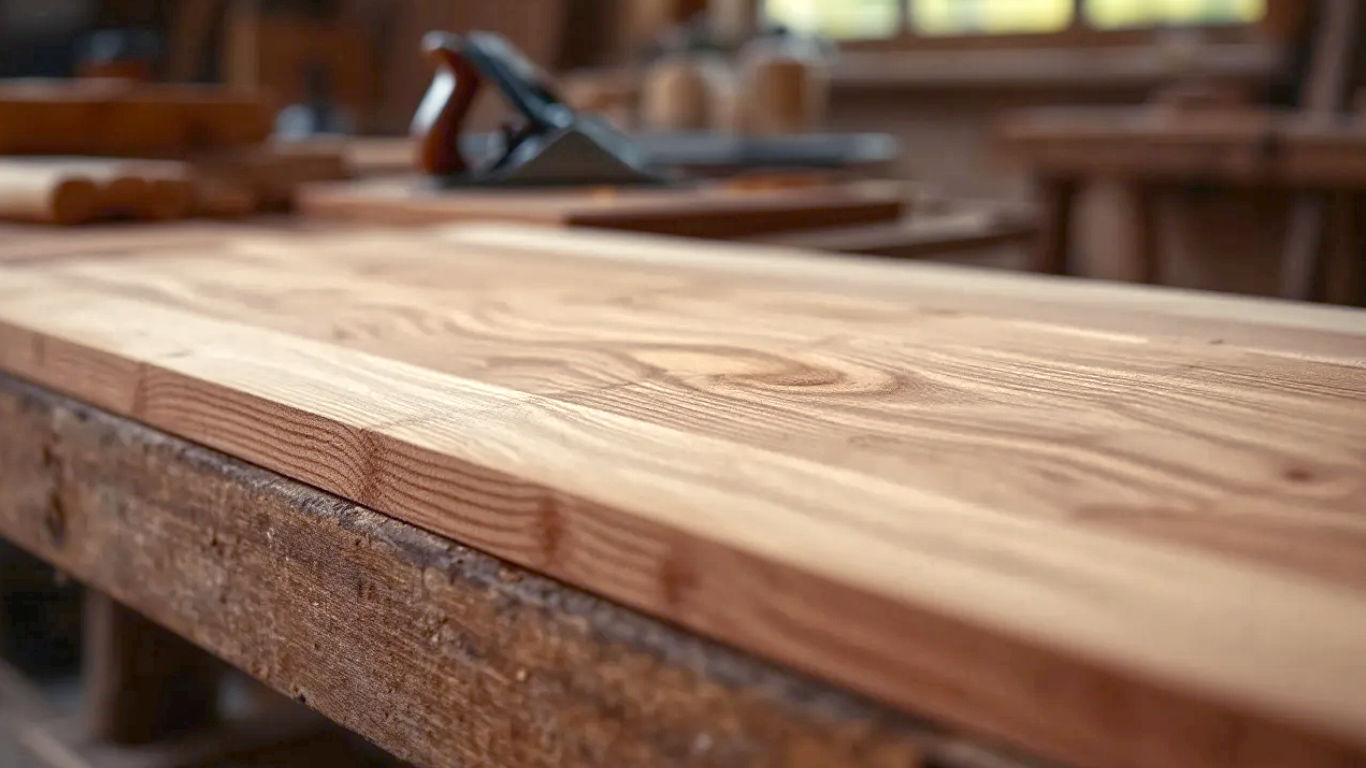
Now for something completely different. Kiri, or Paulownia, is a bit of an oddity. It’s technically a hardwood, but it’s one of the lightest and softest woods in the world. In fact, it’s often lighter than balsa wood! But don’t let its feather-light weight fool you. Kiri is surprisingly strong for its density and has some truly remarkable properties that have made it invaluable in Japanese culture for centuries.
What Makes Kiri So Special?
Kiri’s most obvious characteristic is its incredibly low weight. A large plank of Kiri feels almost unnervingly light, as if it’s made of foam. Its colour is a silvery-white or pale grey, with a straight, even grain and a slightly coarse texture.
But its real genius lies in its stability and resistance to moisture. Kiri wood has a very low shrinkage rate, meaning it doesn’t warp, crack, or change shape much with changes in humidity. This is a huge advantage, especially in a country like Japan (or the UK!) where the weather can be quite damp. It also has natural properties that repel insects and resist rot.
Furthermore, Kiri has a very high ignition point, making it more resistant to fire than many other woods. It’s also a fantastic insulator, keeping things cool in summer and warm in winter.
The Wood of Tradition and Protection
These unique properties made Kiri the perfect material for one very special purpose: making tansu, the traditional Japanese storage chests. Valuable items like kimonos, scrolls, and documents were stored in Kiri chests. The wood’s ability to regulate humidity protected the delicate silk and paper from mould and mildew, while its insect-repelling properties kept pests at bay. It was said that in the event of a fire, a Kiri tansu could be thrown into a well to protect its contents, and the wood would swell to create a watertight seal, floating safely until the danger passed.
This protective quality is deeply ingrained in Japanese culture. It was a tradition to plant a Kiri tree when a daughter was born. By the time she was ready to marry, the tree would be large enough to be felled and made into a beautiful tansu for her dowry, a gift of protection and good fortune to take to her new home.
Working with Kiri: Sharp Tools are a Must
Working with Kiri is a unique experience. Because it’s so soft, it’s incredibly easy to cut and sand. However, you need exceptionally sharp tools. A dull blade will crush and tear the fibres rather than cutting them cleanly. It’s also very easy to dent, so you need to handle it with care on the workbench.
It glues well and takes a finish nicely, though its open pores can soak up a lot of oil or varnish. Traditionally, Kiri was often finished using a technique called uzukuri, where the softer springwood is brushed out with a wire brush to create a textured, three-dimensional surface that highlights the grain. This was then often coloured with a natural pigment and sealed with wax.
Best Uses for Kiri:
- Storage Chests and Boxes: Its primary and most traditional use.
- Musical Instruments: Especially the soundboards of instruments like the koto.
- Linings for Drawers and Cabinets: To protect clothes and other items.
- Lightweight Projects: Such as model making or surfboard cores.
For a British woodworker, Kiri is a fascinating material to experiment with. It challenges our idea of what a hardwood should be. It’s not for making a sturdy workbench, but for creating beautiful, lightweight, and protective pieces, it’s in a class of its own.
5. Sakura (Japanese Cherry) – The Symbol of Spring
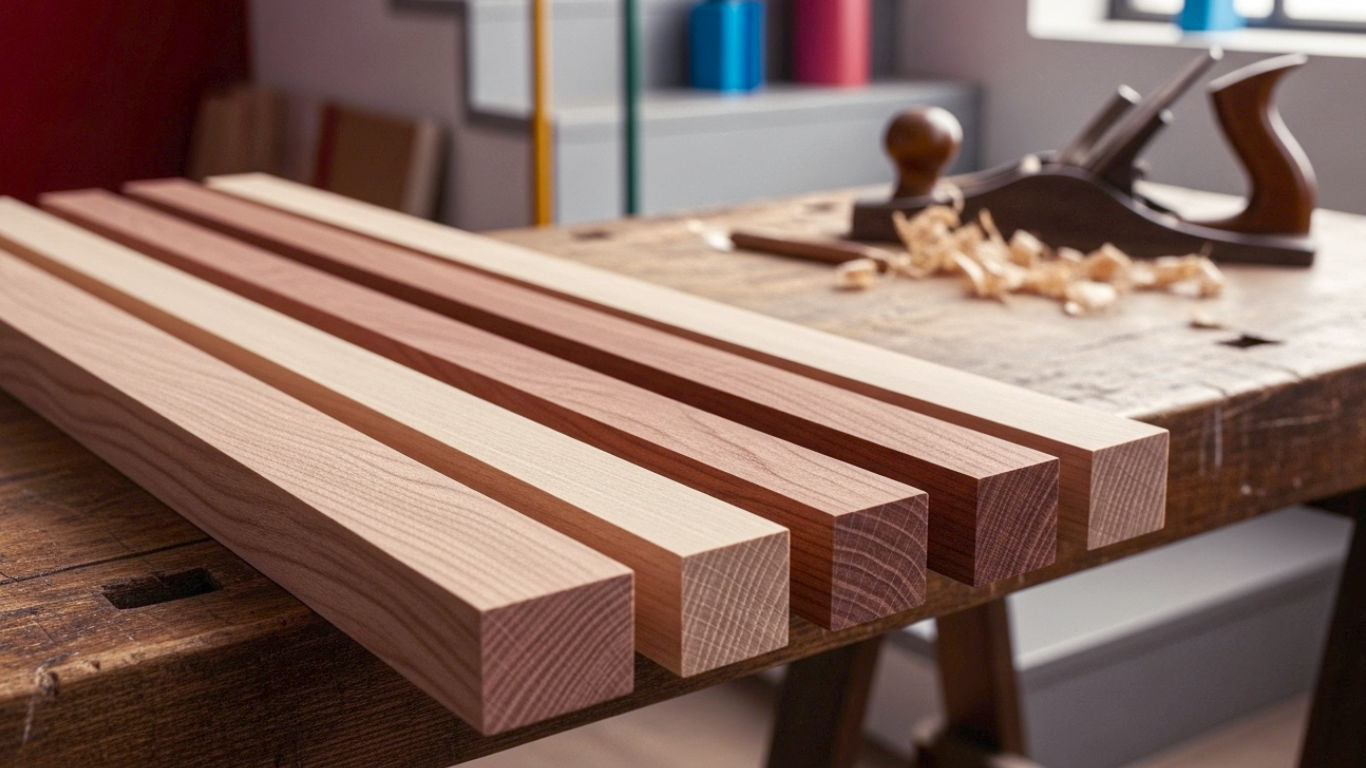
When we think of Japan, one of the first images that comes to mind is the breathtaking beauty of the cherry blossom, or Sakura. But the tree that produces these famous flowers also yields a wonderful woodworking timber. Japanese Cherry is a fine-grained, elegant wood that’s prized for its warm colour, smooth texture, and subtle beauty.
What Makes Sakura So Special?
Sakura wood has a beautiful reddish-brown colour with a hint of gold, similar to its American and European cousins, but often with a finer, more uniform texture. Its grain is typically straight, though you can sometimes find pieces with a gentle wave or curl. It’s a moderately hard and dense wood, making it durable enough for furniture but still easy to work with.
One of its most charming qualities is its smoothness. When sanded and finished, Sakura has a wonderfully silky, tactile feel that makes you want to run your hand over it. It also has a faint, sweet scent when being worked, which is a lovely bonus in the workshop. Like other cherry woods, it ages gracefully, darkening over time to a rich, deep red that adds a sense of warmth and history to any piece.
A Wood of Fleeting Beauty and Refinement
In Japanese culture, the Sakura blossom is a powerful symbol of mono no aware, a gentle sadness at the fleeting nature of life and beauty. The blossoms appear in a glorious burst of colour for just a short time before they fall, reminding us to cherish the present moment.
This philosophy is reflected in the way the wood is used. Sakura is often chosen for small, refined objects that are meant to be held and appreciated up close. It’s not a wood for showing off; it’s for creating pieces with a quiet, understated elegance. It’s also famous for being used to make the woodblocks for ukiyo-e prints, the iconic Japanese art form. The wood’s fine, stable grain was perfect for holding the intricate carved details needed to produce these beautiful images.
Working with Sakura: A Pleasure for the Senses
Sakura is a real pleasure to work with. It cuts, planes, and chisels cleanly with both hand and power tools. It holds sharp details well, making it excellent for carving and intricate joinery. It’s stable and predictable, with very little movement once it’s properly dried.
When it comes to finishing, less is often more. An oil or wax finish is perfect for bringing out its natural warmth and lustre without masking its fine grain. It’s important to be aware that, like other cherry woods, it can be prone to blotching when stained, so it’s best to use a pre-stain conditioner if you plan to add colour. However, its natural colour is so lovely that it rarely needs it.
Best Uses for Sakura:
- Fine Furniture: Cabinets, side tables, and decorative boxes.
- Carving and Sculpture: Its fine grain is perfect for detailed work.
- Kitchenware: High-quality cutting boards, spoons, and bowls.
- Veneers and Inlay: To add a touch of warmth and elegance.
- Printing Blocks: Its traditional use in ukiyo-e.
For a British woodworker, Sakura feels both familiar and exotic. It has the friendly, workable nature of European Cherry, but with a finer texture and a cultural story that adds a unique layer of depth and meaning to the creative process.
6. Nara (Japanese Oak) – The Strong, Silent Type
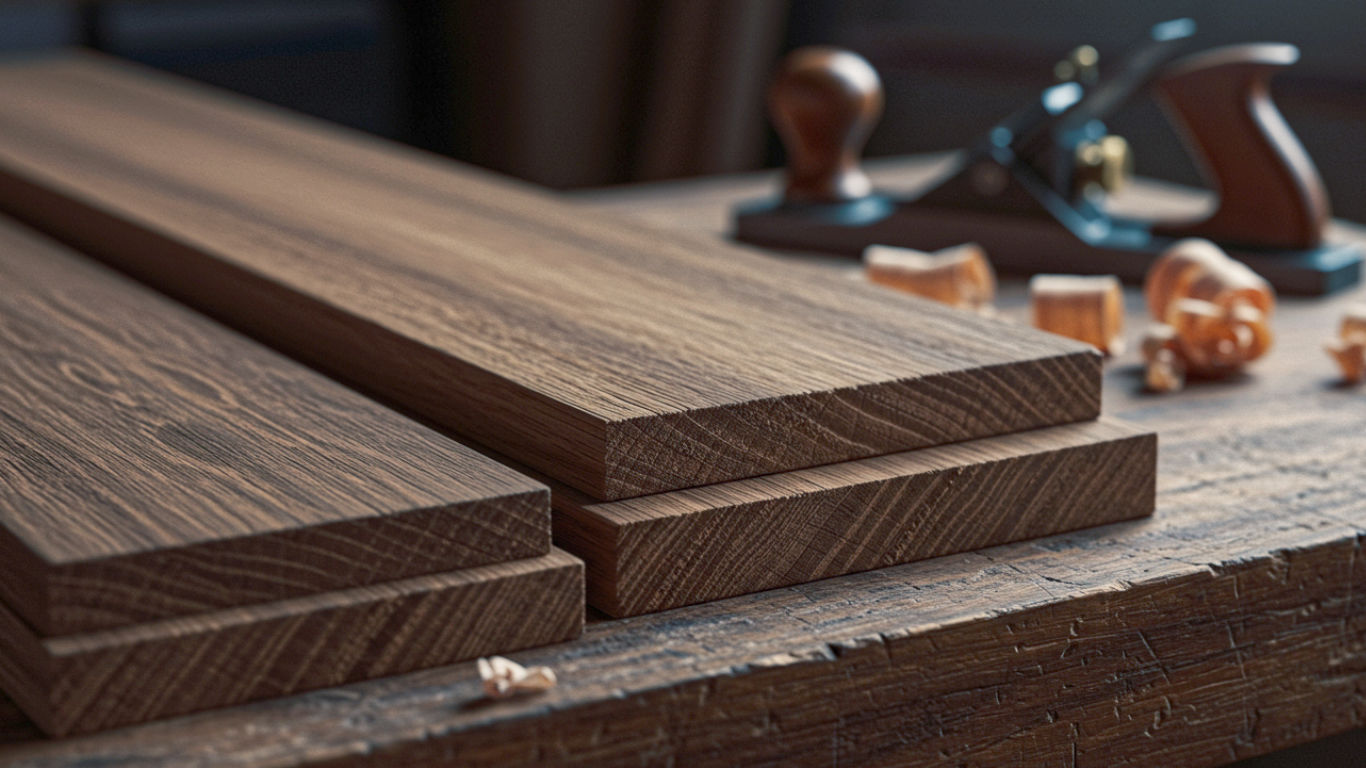
Last but by no means least, we have Nara, or Japanese Oak. Oak is a wood we’re very familiar with in Britain, and Nara shares many of the same qualities that we love: strength, durability, and a timeless, classic beauty. However, Japanese Oak has a refinement and subtlety that sets it apart.
What Makes Nara So Special?
There are several species of oak in Japan, but the most famous is Mizunara (meaning “water oak”). This wood is highly sought-after, especially by whisky distillers around the world (including in Scotland!). Casks made from Mizunara impart unique flavours of sandalwood, coconut, and spice to the whisky, creating a spirit that’s prized by connoisseurs.
In woodworking, Nara is valued for its beautiful grain and colour. It’s typically lighter and more uniform in colour than European Oak, ranging from a pale straw-yellow to a soft golden-brown. Its grain is straight and fine, and when quartersawn, it displays the same stunning silvery rays, known as tora-fu (tiger stripes), that we see in our own brown oak.
It’s also incredibly strong and wear-resistant, making it a fantastic choice for furniture and flooring that needs to stand up to daily use.
A Wood of Enduring Quality
Like oak in the West, Nara is a symbol of strength and endurance. It’s been used for centuries in Japan for furniture, building, and even boat building. Its reliable nature and classic good looks have made it a staple in high-end Japanese furniture design, especially during the 20th century when designers sought to blend traditional Japanese aesthetics with modern, minimalist forms.
The story of Mizunara and whisky is a great example of Japanese ingenuity. During World War II, it was difficult to import oak casks from Europe and America. Japanese distillers had to look for a local alternative. Mizunara was a tricky wood to work with—it’s more porous and prone to leaking—but they persevered and discovered that it gave their whisky a unique and wonderful character. This story reflects the spirit of making the most of what you have and finding beauty in unexpected places.
Working with Nara: A Familiar Friend
If you’ve worked with British or American Oak, you’ll feel right at home with Nara. It’s a hard, dense wood that requires sharp tools, but it behaves predictably. It responds well to both hand and power tools and is fantastic for steam bending.
Like other oaks, it has a high tannin content, so be mindful of iron staining. It also glues and finishes well. An oil finish will give it a warm, natural look, while a fumed finish (using ammonia) can be used to darken the wood and create a rich, antique appearance, really making those tiger stripes pop.
Best Uses for Nara:
- High-Quality Furniture: Especially chairs, tables, and cabinets in a minimalist or Scandinavian style.
- Flooring and Architectural Millwork: Its durability makes it ideal for these applications.
- Whisky Casks: The famous Mizunara casks.
- Turnery and Cooperage: It’s a great wood for making barrels, buckets, and bowls.
For a British woodworker, Nara is like meeting a sophisticated cousin of our beloved native oak. It has all the strength and reliability we expect, but with a finer grain and a lighter, more elegant touch. It’s the perfect wood for creating pieces that are both modern and timeless.
A Final Thought from the Workshop
Exploring the world of Japanese hardwoods is about more than just finding new materials. It’s about connecting with a culture that has a deep and profound respect for nature and craftsmanship. Each of these six woods—the regal Keyaki, the dependable Kuri, the beautiful Tochi, the surprising Kiri, the elegant Sakura, and the refined Nara—offers a unique journey for the woodworker.
They challenge us to be more patient, to sharpen our tools and our skills, and to listen to what the wood wants to become. They remind us that the most beautiful things are often simple, natural, and made with care.
Here in the UK, finding these woods can sometimes be a challenge, but specialist timber merchants are increasingly stocking them. Yes, they might cost a bit more than our local timbers, but for a special project, they are worth every penny.
So, next time you’re planning a new piece, why not consider looking East? You might just find that the perfect wood for your project has been waiting for you in a quiet forest on the other side of the world, ready to share its story in your hands.
Further Reading
For those looking to delve deeper into the world of Japanese woodworking and timber, these resources are highly respected and offer a wealth of information:
- Japan Wood Products Export Association: An excellent resource for official information on Japanese timber species and forestry practices.
- The Wood Database: A comprehensive online database with technical specifications for countless wood species, including those from Japan.
- Japanese Woodworking Tools and Techniques (by Toshio Odate): While focused on tools, this book provides invaluable cultural context and insight into how different woods are traditionally worked.
- Woodwork Magazine and Furniture & Cabinetmaking Magazine: These UK-based publications often feature articles on exotic timbers and international woodworking traditions.




